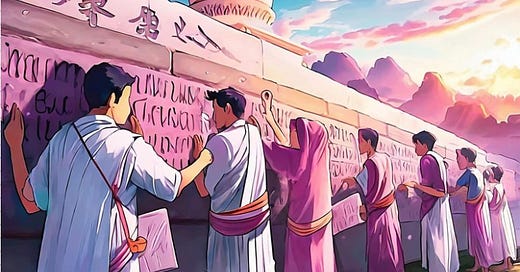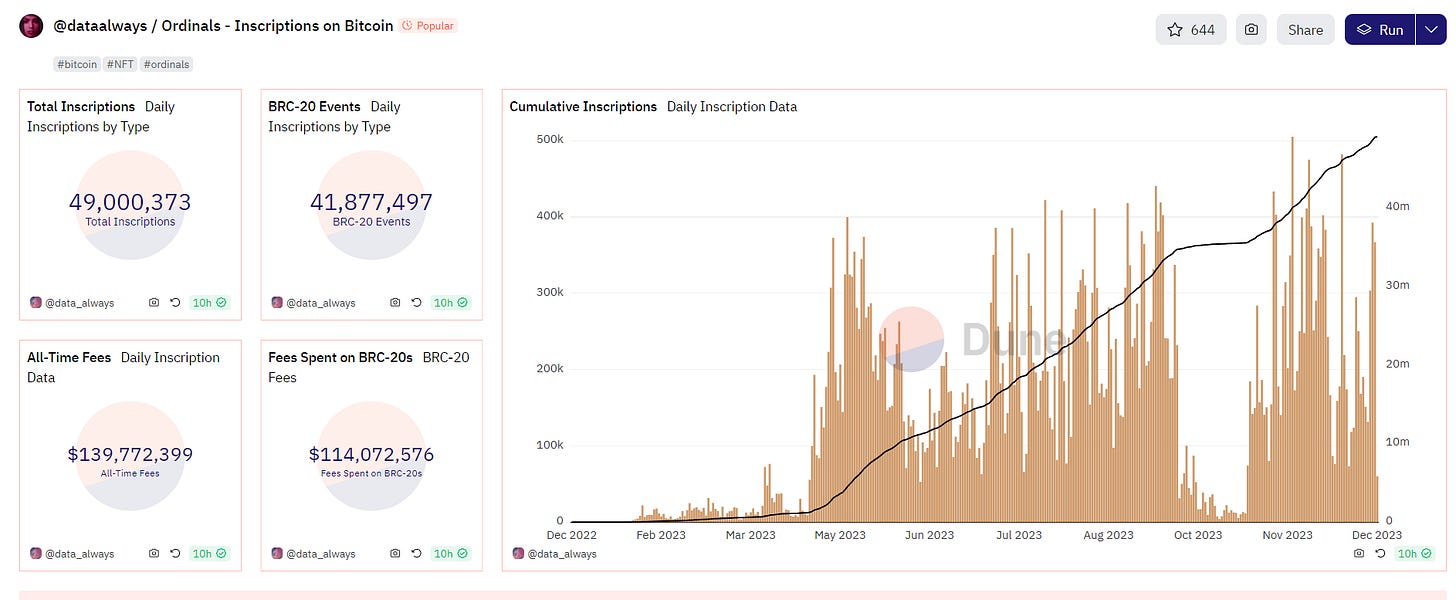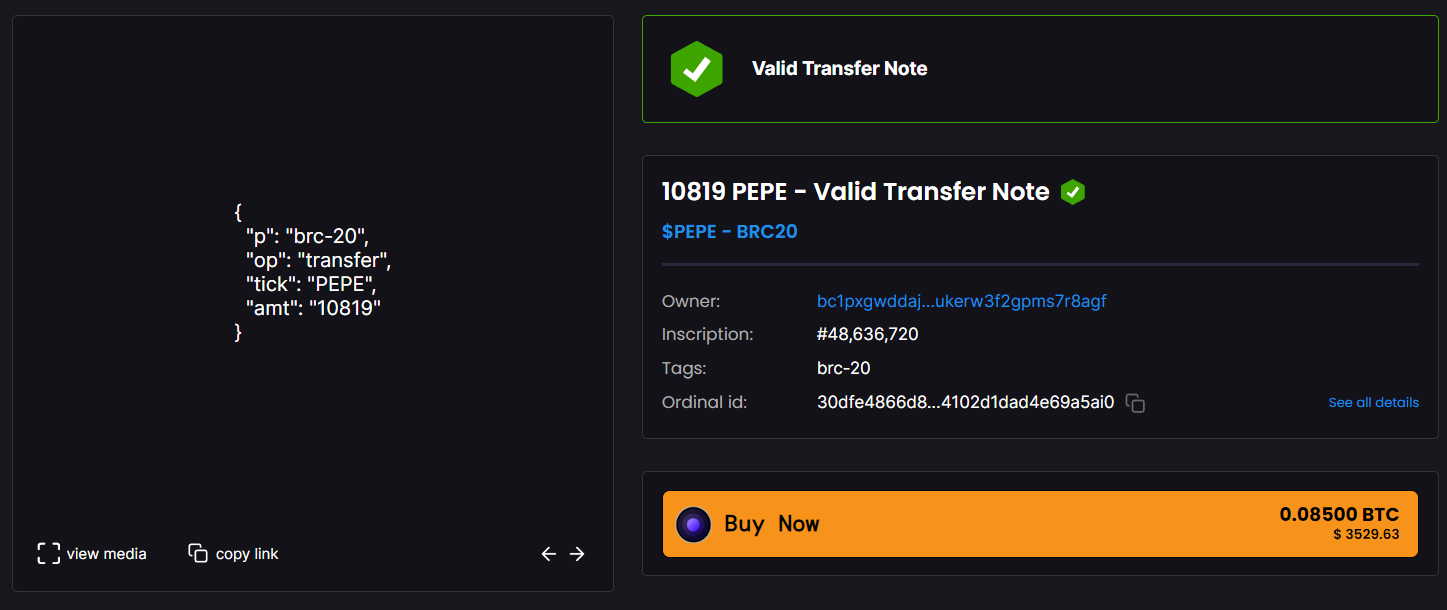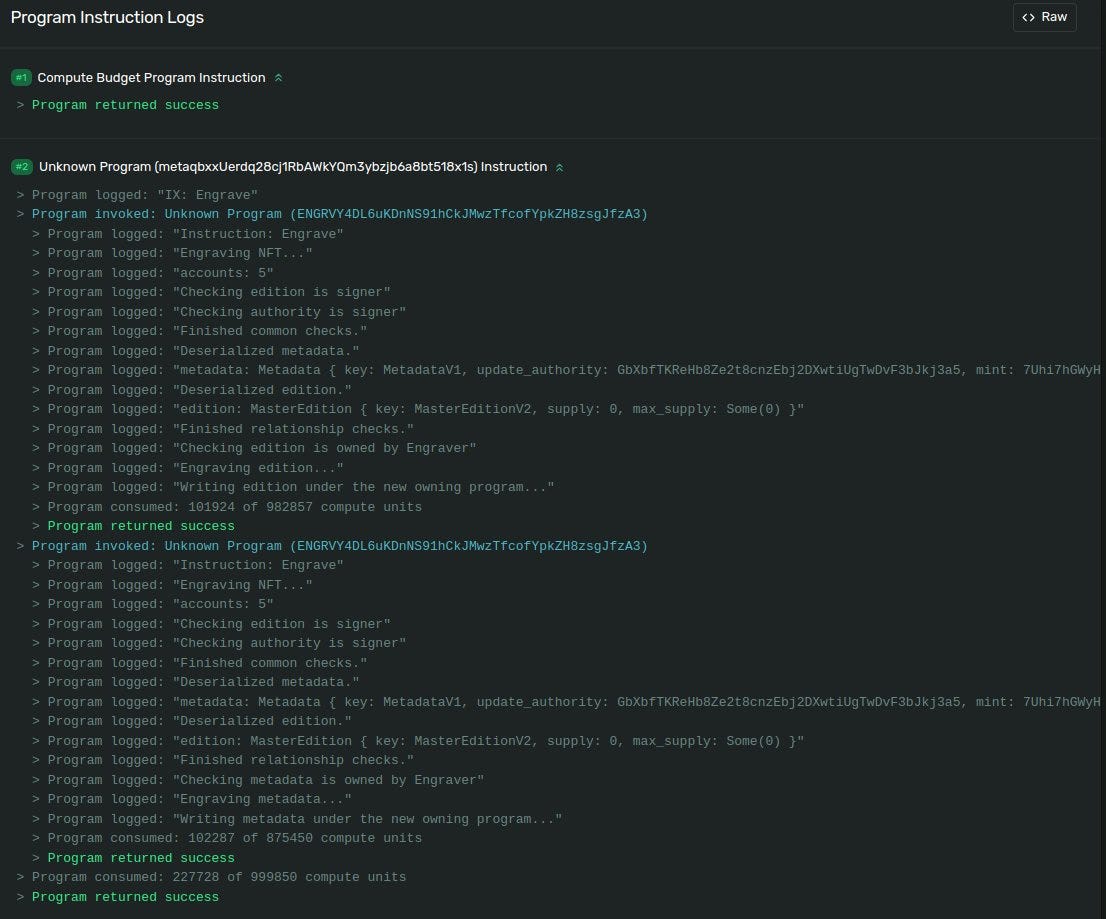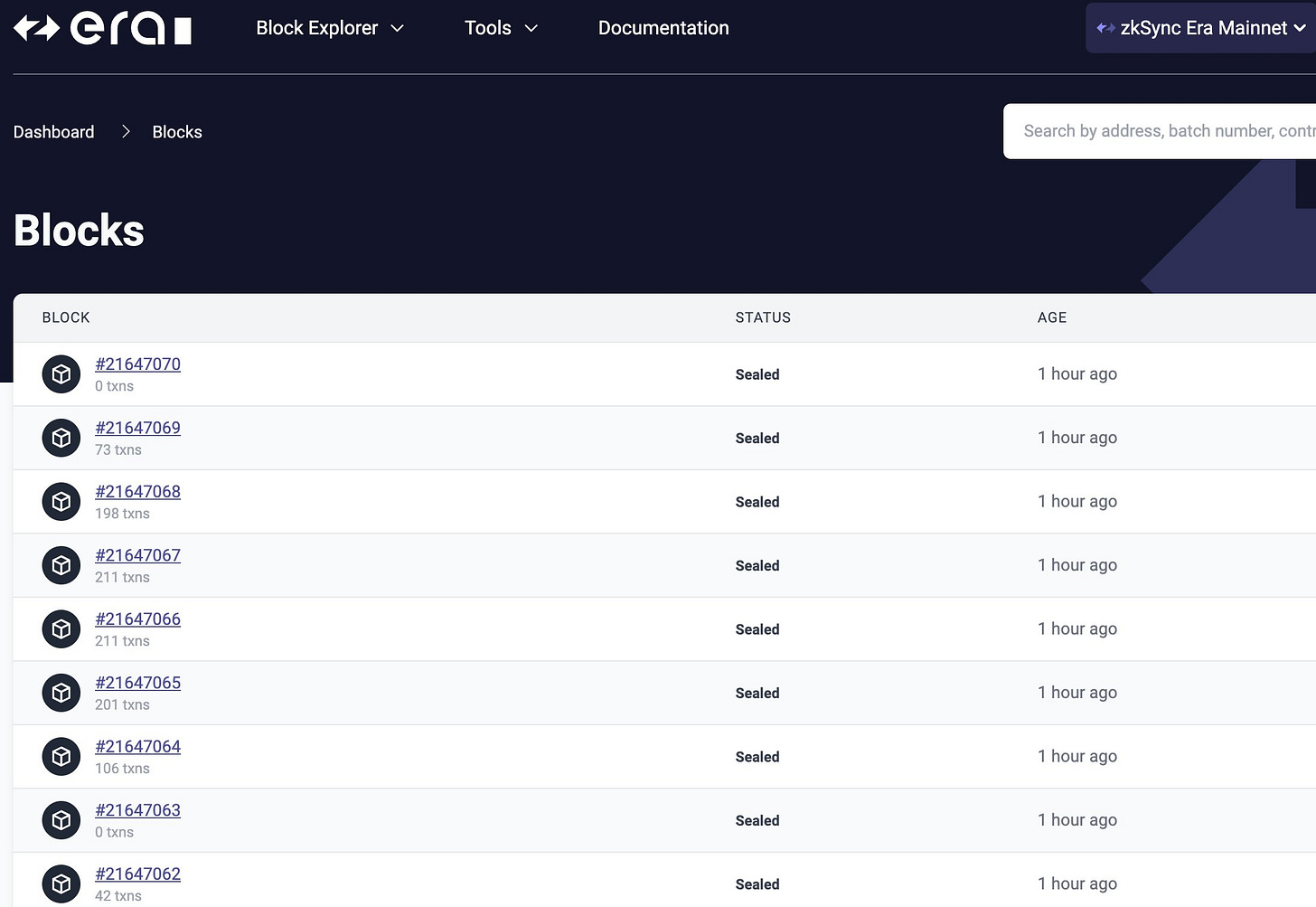Inscriptions : Immutable on chain JPEGs
Etched in blockchain eternity, or just fancy etch-a-sketch? Dive into the truth of NFT inscriptions before your digital Mona Lisa fades.
In the dynamic landscape of blockchain and NFTs, degens are now intrigued by a concept known as "Inscriptions." This article aims to provide an in-depth exploration of the technical intricacies surrounding Inscriptions, shedding light on their role in the NFT ecosystem and the buzz they've generated within the community.
What are inscriptions?
Inscriptions are NFTs that store their metadata directly on the blockchain rather than relying on external storage solutions. This is a significant shift, as traditional NFTs typically only store a pointer to their metadata on-chain, with the actual metadata residing off-chain on services like IPFS or Arweave.
While on-chain storage is more expensive, inscriptions offer several key advantages:
Enhanced security: Metadata is permanently and immutably linked to the NFT, reducing the risk of link rot or tampering.
True ownership: Owners have complete control over their NFTs, independent of external services.
Increased transparency: All metadata is publicly verifiable on the blockchain.
Inscriptions are a promising innovation that has the potential to revolutionize NFT storage and management, fostering a more secure, decentralized, and transparent ecosystem for digital assets.
Inscriptions get fascinatingly specific on different chains. Let's ditch the generality and delve into the nitty-gritty of how these chain-specific inscription mechanics work.
How did Bitcoin ordinals lay the foundation for this concept of inscriptions?
We all know Bitcoin doesn't support smart contracts, and people have been trying out various ways to use it outside of the payment layer. Various L2s, like Lightning network and Stacks, have been built on top of Bitcoin to compete and make Bitcoin the single network for all the use cases.
Out of searching to implement NFTs, inscriptions were born. Not because there was an alternative way, but it was the only way as it doesn't support Programs.
This metadata, aka text, images, and videos, were inscribed on the satoshis (sats), which was possible due to the taproot update on 14 Nov 2021. The new protocol, Taproot, preserves privacy on the Bitcoin blockchain by obscuring complicated transactions and also increases the amount of data allowed in Bitcoin blocks. It also made them cheaper and more lightweight.
It is important to note that only Taproot-enabled addresses can be used for any inscriptions on Bitcoin
Each block size in Bitcoin is limited to 1 MB, while the taproot upgrade was able to push it up to 4MB to enable inscribing data on-chain for ordinals. Inscriptions were done in the order of sats, and the early inscribed sats gained momentum and popularity among degens.
Buying an early/less ranked inscription creates FOMO of buying in, the same way any limited tokens would sell, except these are on-chain embedded.
This led to the birth of new trading FOMO which includes Rare, Exotic, sub 1k, sub 10k, uncommon, black rare and uncommon, Cursed, Palindrome, Block 9, Block 78, Pizza, Nakamoto, First transaction and many more who knows what Sats
Thanks to the popularity of Ordinals, fees on the Bitcoin network skyrocketed in the month of Feb 2023 and over $1.31 million in fees have been paid to miners on the Bitcoin network. A lot of wallets and marketplaces, like Gamma, Unisat, Xverse and Ordinals Wallet, came out and supported Ordinals by starting a no-code launchpad, in-wallet views etc.
Soon, Fungible Token standards were born too, which were called BRC-20s.
BRC-20 does not rely on smart contracts, unlike popular token standards on EVM blockchains. Instead, it allows users to store a script file on Bitcoin, associating tokens with specific satoshis. BRC-20 tokens can be deployed, minted, and transferred by embedding JSON data into ordinal inscriptions.
Although both utilize ordinal inscriptions, their approach to data storage and interaction with sats differs significantly.
BRC-20 tokens are not directly inscribed onto individual satoshis. Instead, they utilize a two-layer approach:
Script Inscription:
A script file containing the BRC-20 token's rules and information (e.g., total supply, transfer logic) is inscribed onto the Bitcoin blockchain using ordinal inscriptions.
This script acts as a central point of reference for the token's existence and behaviour.
Satoshi Allocation:
Specific satoshis are not directly linked to individual BRC-20 tokens. Instead, the token's total supply is tracked within the script, and ownership is defined by transaction history and public keys.
Users who own BRC-20 tokens hold them not as specific satoshis but as entries in the token's ledger maintained by the script.
This has its own advantages like efficiency and standardized rules for token behaviour, facilitating compatibility and integration; they also possess single entity risk and not so flexibility, unlike ordinals.
Hereby, I have attached a tutorial by MagicEden on how to Deploy and mint your own BRC-20.
Soon, all other chains started looking into implementing this same old inscription, although they have contracts and virtual machines to implement them efficiently, they preferred doing them for adopting new methods.
Inscriptions on EVM Chains (Ethscriptions/Avascriptions… )
Instead of inscribing data on individual SATs, EVM inscriptions inscribe data in transaction calldata.
Calldata is optional but immutable data that can be sent in a transaction. This data is mostly used when passing inputs to smart contracts. It is included in the "Data" field of an Ethereum transaction when you send it to the network. It's also used for rollup data. It is read-only and cheap to use, especially when compared to storing data in a smart contract state.
The JSON Parameters are pretty much the same as BRC-20s and are called xRC-20 tokens.
A special format of calldata(transaction input data) is used to represent token functionality. Unlike ERC-20 tokens, xRC-20 relies on off-chain servers and logic for token management, validation, and transfer. Off-chain "indexers" interpret transaction calldata and verify token existence, validity, and mint/transfer legality, while operations are encoded in the calldata for the minting and transferring tokens.
This has trust reliances on off-chain entities, decentralization risks and a lot of discrepancies still exist. But the upside is that everything is cheap and completely on-chain. xRC-20 txns and NFT metadata are all stored on-chain and available for everyone to read.
The EVM was designed to support smart contract logic, but inscriptions literally move all the computation off-chain. This leads to more fragmentation and less composability.
While this whole narrative is being run on the success of BRC-20s and inscriptions, a lot of these on EVM are just bots and spams coping up to expect some success the same way BTC achieved, lol, just because the transactions are pretty cheap compared to smart contract transactions.
For more data and insights on EVM inscriptions, feel free to refer to this Dune dashboard
Inscriptions on Solana (Solscriptions)
Blockrons: The first on-chain NFT collection on Solana
Started on Dec 27 2022 (almost a year ago👀), as the first 100-pixel art, Blockrons are the first on-chain collection on Solana. Each art is revealed every Wednesday on an auction basis at Exchange Art, and currently, 56 have been revealed to date.
S/T to Hamster_labs, currently a libreplex contributor for building one even before any established tech was made and for pushing inscriptions on Solana for more than a year.
Libreplex:
Libreplex is a community-driven open protocol that is focused towards establishing highly open-source digital asset management for Solana.
The current standard on the token metadata program is owned by Metaplex, which is a private company that also posses the risk of increased fees, unilateral design changes and even loss of control of assets. Metaplex is a well-established organization that has been a monopoly ever since a standard on Solana was born, and these monopoly risks aren't a good way to make Solana more decentralized.
LibrePlex aims to mitigate this problem by introducing a fully community-driven Metadata protocol that is free of commercial interests. The new protocol will be owned by a consortium with distributed deployment keys, which plays a major role in maintaining fundamental shared control with no single entity established.
While a lot is still in the works for libreplex, most of the new protocols prefer metaplex over libreplex for stability and to avoid risks in the token standards for the short term.
Although metaplex has a huge impact in setting up the standard by doing a lot of heavy lifting for the initial phase of development, it is good for the ecosystem to have competitive standards for users to choose from, and we are seeing this with the current inscriptions play between the two.
Here are a few claims made by libreplex between the two standards below:-
While the metaplex standard(inscription) is still available only on devnet, with security audits yet to be done, libreplex was early and provided the inscription standard on mainnet that many protocols in the community comply with.
Inscriptions like Sols and Solmaps hit an all-time high sales in overall transactions across multiple chains that were developed on the standards made by libreplex, and marketplaces like Tensor, magiceden, and Okx are already supporting Solana inscriptions even before metaplex standard is out yet.
Metaplex’s Inscription standard
On Dec 19, 2023, Metaplex announced their inscription standards and Engravings that are fully on-chain and immutable are live on devnet.
Inscriptions
Inscriptions on metaplex allow you to store an asset’s metadata and media fully on Solana, removing any external trust assumptions and unlocking greater composability for on-chain attributes and smart contracts. Features such as dynamic metadata and images, on-chain attribute orders, and trait-locked smart contracts all become possible with inscribed metadata using this standard.
Metaplex inscriptions have two operating modes:
Metadata inscribing
Direct data storage
In both modes, binary data of any format can be directly written to the chain through the Metaplex Inscription program.
The Metadata inscribing method creates a PDA attached to a mint account, the same way Metadata is attached to a token mint. The JSON and image data of the NFT can then be written directly to the chain in the PDA. Mint inscriptions also include a ranking, which offers a FCFS rarity claim when inscribing an NFT and are ranked in the minting order.
The direct data storage can be used as a direct alternative to providers like Arweave and IPFS rather than as a backup. JSON and Image data can be written directly to the chain.
This metadata inscribing order creates an issue between both the standards as metaplex is trying to ignore close to 1.3 million Solana Inscriptions that are already on chain with the libreplex standards, and it is up to the community to decide the end state and integrate them.💀
Libreplex standard for inscriptions is expected to be immutable before March 2024 and metaplex standard is expected to be immutable within 6 months after all the security audits.
Engravings by Metaplex
In addition to inscriptions, they also enabled engravings calling it Solana’s first truly immutable NFTs.The Engraver adds an extra layer of security that prevents any changes from ever being made to Engraved NFTs, regardless of whether the originating program is immutable. The Engraver would be an immutable program itself (i.e. upgrade authority is burned) and, therefore, not prone to the issues of Solana program upgrade authority.
This seems pretty cool as the libreplex isn't completely immutable from the user's perspective, as one can close the account created and claim the rent back.
Try engraving using the MPL-Engraver or inscribing using the MPL-Inscription program on Devnet.
Are Inscriptions really bloating the state of Solana? 🤔
Not really at the moment.
As per this dashboard made by Noah from Solana Labs, very little space is taken to write inscriptions onto the current state in the month of December, which is the maximum number of inscriptions ever on Solana.
However, Infrastructure providers might be having a hard time managing loads of on-chain states in indexing and providing infra to users.
Helius DAS API supports Inscriptions if you are looking to use them.
Solscribe: Inscriptions Tool built on the Libreplex standard
Solscribe is an inscription tool on Solana that lets you inscribe, bulk inscribe, Deploy and mint SPL-20s and even repair and reinscribe your inscriptions using the Libreplex metadata standard.
It is advisable to first compress the image and turn it into webp format before you inscribe it, as you will pay Solana in rent fees depending on the size of the image.
Although the cost is too high, these are rent reclaimable. Inscriptions can be burnt, and the rent can be claimed back.
While storing on-chain is not so efficient, it is a balance and a tradeoff between having your jpegs on-chain, which is completely immutable or storing them in an external, not-so-immutable way.
SPL -20
Again SPL-20 tokens are inscribed the same way we have BRC-20s on Bitcoin.
They are fungible tokens with inscribed text with a fair launch of no white lists /Presales or any beforehand Allocations and are also free to mint and self-inscribing. Libreplex claims that they can be bridged into SPL tokens and vice versa.
Once the ticker is deployed, anyone can claim the token and inscribe for free, but this has been getting botted mostly due to the free money.
Anyone can also run an SPL-20 validation tool to auto-validate their inscription.
The SPL-20 fair launch takes place via libreplex fair launch, which automatically validates at the time of inscription. This page shows all Fair Launches, as well as Launches migrated from legacy validators.
Inscriptions breaking chains
Multiple chains like Tron, BNB, avalanche etc.. were heavily suffering due to high on-chain loads leading to gas/tx spikes, downtimes and many other issues.
Few Examples below:-
BNB Chain had no gas spike, but seems like it was down for 5 hours recently.
Celo had huge gas spikes, making it hard to use for normal transactions.
Spammed txns on arbitrium overwhelmed the sequencer itself, preventing the L2 txns from being executed. This got the sequencer down, and once it was back again, there were a lot of pending transactions for which the gas spiked up, causing
Inscription attacks on avalanche caused gas spikes up to 10$, with 91% of all its transactions being inscriptions.
Zksync era stopped processing blocks for a few hours.
Aptos survived and peaked with 2.1B transactions in a day. ( a win )
Transactions on Solana hitting particular programs (only the high-in-demand inscription mints ) weren't user-friendly, as many were not able to mint out due to failed transactions.
Conclusion:-
At this point, it all seems like we are using these global state machines to compete with each other just to have fun minting these inscriptions in a highly inefficient way, and Solana, and Aptos still managed to maintain these loads of on-chain transactions.
While few degens care a lot when it comes to having their metadata stored directly on-chain, most of the current mints are either botted or claimed for free money.
It is always fair that we have such standards to gamble as well as to enable something new in the ecosystem that achieves true immutability. It is also getting interesting to see if it really unlocks greater composability for on-chain attributes and programs.
